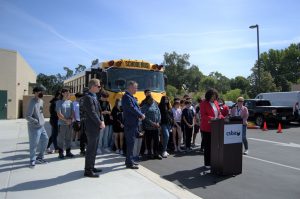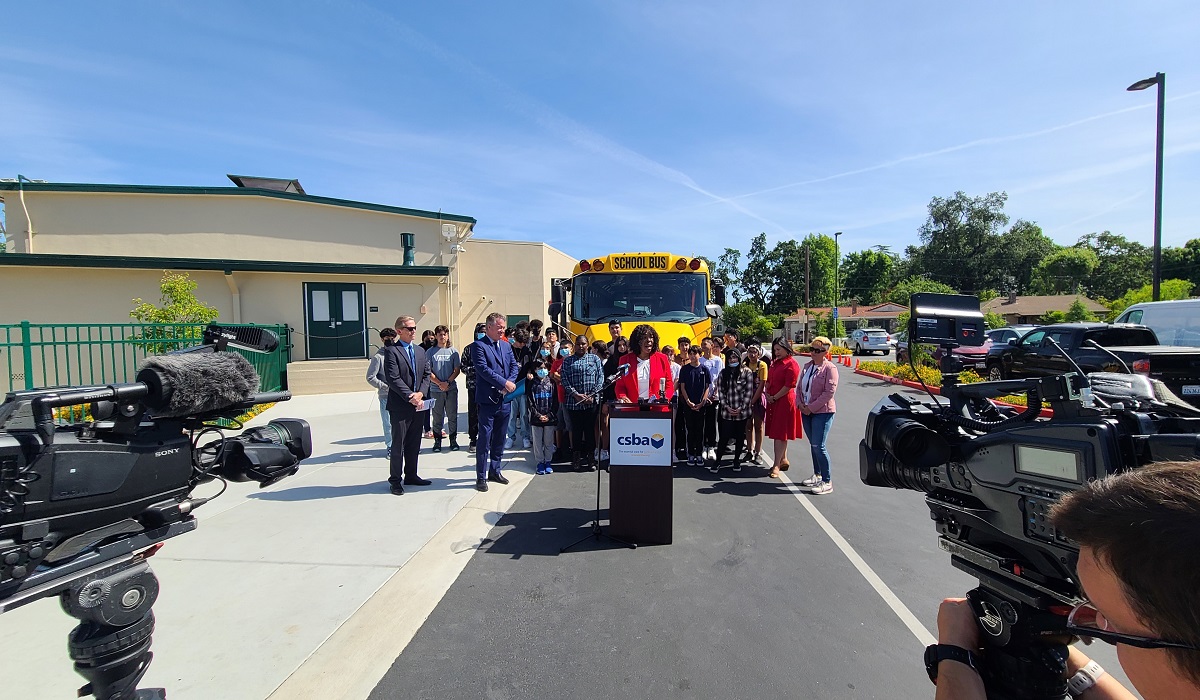CSBA and Assemblymember Patrick O’Donnell (D-Long Beach) held a press conference today in support of Assembly Bill 2933 at Westmore Oaks K-8 School in West Sacramento’s Washington Unified School District.
The CSBA-sponsored bill would hit the brakes on decades of underinvestment and fully fund home-to-school transportation.
State funding is currently locked in for each school district at levels from 1981 with no cost-of-living adjustment to address rising expenses.
“California’s home-to-school transportation program has been unbelievably frozen for 40 years. For 40 years there has not been an increase in funding for the transportation system that gets kids to school and gets them educated. It’s time to change that,” said O’Donnell, the bill’s author.
With a grin, O’Donnell gestured to the school bus behind him, adding for context, “I rode a school bus like this in the 80s, probably listening to something on my Walkman — some Flock of Seagulls.”
Today, California ranks last nationally in home-to-school transportation with roughly one in 10 students taking a bus to school and most school districts and county offices of education only offering busing to those in special education programs.
“The program is in need of repair and I’m not talking about [an] oil change kind of repair or a tune up. It’s in need of some serious repair work when it comes down to how the program is funded,” said CSBA Assistant Executive Director of Governmental Relations Dennis Meyers.
In his May Budget Revision, released on May 13, Gov. Gavin Newsom failed to allocate funding for the cause.
“We have a significant amount of ongoing money in the state budget this year and we can change that,” O’Donnell said. “California currently reimburses schools for less than 30 percent of home-to-school transportation costs and dozens of districts actually get less than 10 percent of the costs associated with getting kids to the classroom every day.”
“When schools aren’t fully compensated, schools must spend general fund dollars on transportation, diverting resources out of the classroom,” O’Donnell continued. “AB 2933 also provides for future program growth as schools increase their capacity to meet increased demand requiring more buses and routes. These costs will be covered for every school district and every child. No more will we have to take money out of the classroom to fund transportation.”
Benefits of school busing programs
As school communities continue to rebound from the pandemic and work to address academic recovery, physical and mental health, social-emotional learning and more, getting students to attend school on time, every day is more important than ever.
School busing offers numerous proven benefits such as boosting attendance, increasing access to instruction, programs and services, enhanced student safety, reduced driving for families, lighter traffic and lower pollution.
During the event, Washington USD Superintendent Cheryl P. Hildreth spoke on the benefits that full funding for home-to-school transportation could have for local educational agencies and the students they serve. Washington USD has an enrollment of approximately 8,000 students.
“We strive to ensure that all students are provided equitable opportunities to reach their fullest potential and graduate with the skills needed to succeed at the next level of their journey — but oftentimes, schools can’t do everything alone,” Hildreth said. “We hear this time and time again that it takes an entire village to raise a child. That’s where AB 2933 comes into play. It’s a major boost to funding and a way to expand our infrastructure for home-to-school transportation, making sure students get to school each day safely and on time. By fully funding home-to-school transportation, a huge economic burden is shifted, and districts gain additional flexibility to narrow their focus on other essential student programs.”
Edris Ahmadi, an eighth-grade student at Washington USD, shared some of the benefits of riding the bus to campus each day.
“My parents go to work very early in the morning so I wouldn’t have any transportation besides walking or biking [to get to sch ool]. The bus has helped me a lot because it gives me an opportunity to get to school on time and go back home on time safely. I like the buses because they have great air conditioning and are safe. So overall, this program has helped me a lot and could also help others,” Ahmadi said.
ool]. The bus has helped me a lot because it gives me an opportunity to get to school on time and go back home on time safely. I like the buses because they have great air conditioning and are safe. So overall, this program has helped me a lot and could also help others,” Ahmadi said.
CSBA’s Meyers noted that no one is asking the state to mandate the program, but rather, to fund it as the interest is there.
“If you ask superintendents and school board members and transportation folks: ‘if you start getting 100 percent of your costs reimbursed, would you rebuild your programs?’ Every one of them nods their head yes,” Meyers said.






